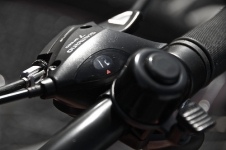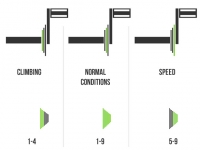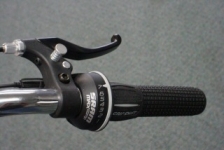Bike shifters



Shifters are controls that allow a cyclist to change cogs of the rear cassette on-the-fly, distributing power throughout a range of gears. This mechanism is actuated by tightening or loosening the tension on the shifter cable, raising or lowering the derailleur to the correct setting, guiding the chain onto the new selected gear. Most shifters have settings adjusted to locate the cogs immediately. This allows the rider to focus on riding, but it wasn't always that easy.
- Friction shifting - In the beginning, shifters were essentially a lever that pulled the cable to and fro, without any guide from gear to gear. You just had to feel it. Cassettes were simple (3-5 sprockets), but the rider had to take his hands off the bars to change gears. Sometimes the chain would get mixed up mid-shift and fall between the cogs, causing a flurry of problems. "Just feeling it from gear to gear was difficult and led to poor performance. Friction shifting is still alive and well today as there actually are benefits, like going from the smallest cog to the largest one in a single flick of the wrist. There have been innovations such as ramped sprocket wheels and floating jockey wheels that help this style remain popular, especially with front derailleurs.
- Index Shifting - To make things easier (and safer) for the rider, index shifting was invented. Simply put, the shifter has precise 'stops' that correspond to each gear either on the (rear) cassette, or the crank (front). The rider is now able to find the right gear flawlessly and immediately. Rapidly shifting lets the rider maintain a steady pedaling cadence and have more control over the bars at the same time. Index shifting incorporates more hardware (making it heavier), and requires the finesse of setting and periodically adjusting the shifter, cable, and the derailleur. However, these costs are largely undermined by the benefits of boosting performance and usability of the bicycle. Index shifters have been around since 1984, and now come in a variety of forms such as a trigger, bar end, twist shifters, and even mounted on the down tube of the bike! Down tube gear levers make everybody else look like sissies. Look mom, one hand!

Shifters and assorted parts can be purchased online on the cheap. For around $20 you can find many types of low-end shifters (all but the integrated variety). Decent shifters with brand names start around $50, and from there the value increases linearly into the several hundreds of dollars.

Some specialized integrated shifters go for over $1,200 on Amazon.com.
Installing or repairing a shifter needs some focus. Making adjustments affects the entire system, and something very simple can lead to cable tension being different, or a misaligned derailleur.
First things first, remember that shifter cables are different than brake cables. There are new, more versatile housings being made, but as a rule they are not interchangeable. The stress of braking would snap a shifter cable. Shifting with a brake cable, much like walking a dog with a large wet noodle, would also lead to big problems.

Weather can wreak havoc on shifting components, so sometimes it's necessary to take apart the hardware and clean the rust and gunk. Don't be shy with degreasers and lubricants.


Regardless of the mechanism that actuates the shift (twist shifters, trigger, thumb, or flappy paddles), installation means mounting the shifter in a comfortable location on the bars and properly adjusting the cable. Most shifters clamp to the handlebars via pinch bolt (likely a phillips, 3mm, or 5mm hex).

For more information on cleaning, lubing, and installing shifters and cables, check out our tutorials below.
Bike handlebars come in many shapes and sizes and as such, so do the shifters mounted on them.
Friction shifters: Rear derailleur is held in place by friction of the cable and shifter. It falls on the rider to find the correct setting for each gear.

- Down tube shifters - Unusually large paddles mounted on the down tube of the frame. Largely obsolete, some reckless cycling purists still enjoy the suicidal design of down tube shifters. One of the first designs, apparently the plan was to move the shifter closer to the rear derailleur than to the hands of the rider. Genius. Down tube shifters are lightweight and simple, but changing gears can become a juggling act you might not want to participate in during rush hour traffic.

- Stem shifters - Mounted on the stem of the bicycle was certainly an upgrade. They were often paired with drop handlebars and because they sat on top, stem shifters encouraged lazy riding form. The cool and stylish rider could loosely rest their hands on the top of the bars and because the hands were so close together, it gave very little control of the bike.
Drop handlebars

- Bar-end shifters - Shift levers are inserted in place of handlebar plugs. Commonly indexed on the right (rear derailleur) but friction on the left (front derailleur), bar-end shifters are very common.



- Combo/integrated shifters - A highly advanced style of indexed shifter used on many modern bikes with drop bars, integrated shifters are the new normal. The brake lever is still applied on a Y-axis to the handlebars, but doubles as the shifter when a separate lever is pressed to the side for an upshift. Downshifting has a separate lever near the riders thumb on the bars. As usual, Campagnolo and Shimano have separate patented integrated designs.
-
Upright handlebars

- Thumb shifters - Indexed shifters that sit atop mountain bike handle bars. Old but gold, thumb shifters are simple and low profile. Pulled back and forth for shifting up and down.

- Twist shifters - Rotating the shifter on the handlebar acts as a pulley tightening or loosening the shift cable.


- Below bar/Trigger shifters - Separate triggers for upshifting (thumb) and downshifting (index finger). Stationed below the handlebars, staying clear of the rider's teeth during a crash.